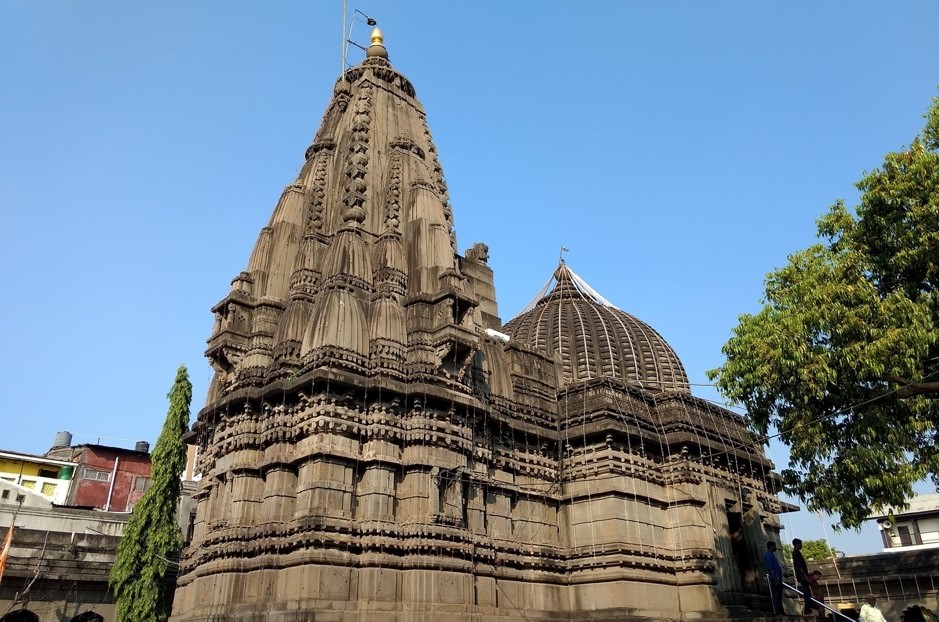Description
 Disclaimer: Copyright infringement not intended.
Disclaimer: Copyright infringement not intended.
Context
- Prime Minister Narendra Modi's recent visit to the Kalaram Temple in Nashik has brought attention to this revered Hindu shrine, situated on the banks of the Godavari in the Panchavati area.
- The temple, with its black-color idols of Lord Rama, Sita, and Lakshman, holds deep historical, religious, and cultural significance
Details
Historical Significance
- The Kalaram Temple derives its name from the black statue of Lord Rama, where "Kala Ram" translates to "Black Ram."
- The original temple, believed to be from the Rashtrakuta Period (7th to 11th centuries), was dedicated to an unknown deity.
- The temple, built in 1792, was an endeavor led by Sardar Rangarao Odhekar.
- Legend has it that Odhekar dreamt of a black-colored statue of Lord Rama in the Godavari River, recovered the statues, and constructed the temple.
Connection to Ramayana
- Panchavati, the region where the temple is situated, holds a special place in the Ramayana and Hindu religion.
- Lord Rama, along with Sita and Lakshman, spent the initial years of their 14-year exile in the dense forest of Dandakaranya, of which Panchavati was a part.
- According to the Ramayana, after ten years of exile, Rama, Sita, and Lakshmana spent two and a half years on the northern bank of the Godavari near Nasik, known as Panchavati.
- The name Panchavati is derived from five banyan trees in the area, and it is where Ravan abducted Sita, setting off the events leading to the Ramayana war.
Babasaheb Ambedkar's Satyagraha
- The Kalaram Temple is not only a religious site but also the site of a significant Dalit satyagraha led by B.R. Ambedkar in 1930.
- Ambedkar and social activist Pandurang Sadashiv Sane led an agitation demanding temple entry rights for Dalits.
- The satyagraha continued until 1935, marking a crucial event in the Dalit movement for social equality.

Unique Features of the Temple
- A black idol of Hanuman is placed at the main entrance.
- The main temple has 14 steps, symbolizing the 14 years of Rama's exile.
- It also features 84 pillars, representing the cycle of 84 lakh species one has to complete to be born as a human.
- A significant feature is an ancient tree with impressions of Lord Dattatreya's footprints on a stone beneath it, adding to the sanctity of the temple complex.
Architectural Significance
- The temple's architecture follows the Hemadpanti style, known for intricate carvings and sculptures, contributing to its aesthetic appeal.
Spiritual Ceremonies
- During his recent visit, Prime Minister Narendra Modi attended a recitation of the Bhavarth Ramayana, emphasizing the temple's connection to religious scriptures.
Conclusion
The Kalaram Temple, with its rich history, cultural relevance, and the enduring spirit of devotion, continues to be a prominent pilgrimage site and a symbol of unity and spirituality in Nashik.
|
PRACTICE QUESTION
Q. The Kalaram Temple in Nashik holds historical significance. Which of the following statements is correct?
A. The temple was originally dedicated to Lord Shiva during the Rashtrakuta Period.
B. Sardar Rangarao Odhekar led a satyagraha at the temple in 1930 demanding temple entry rights for Dalits.
C. Panchavati, the region where the temple is situated, has no connection to the Ramayana.
D. The main temple has 14 steps, symbolizing the 14 years of Lord Rama's exile.
Answer: D.
|





 Disclaimer: Copyright infringement not intended.
Disclaimer: Copyright infringement not intended. 








